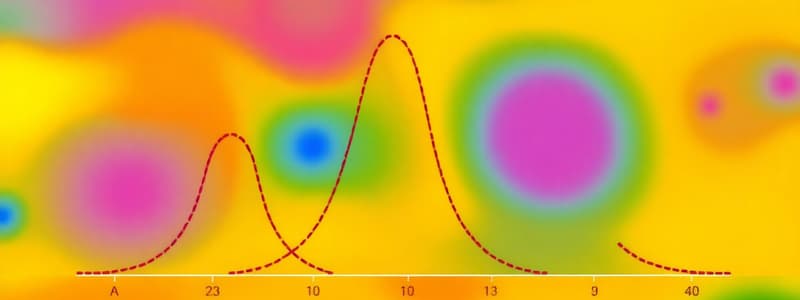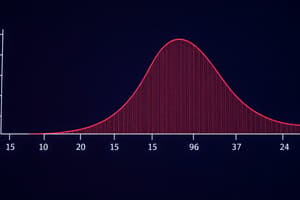Podcast
Questions and Answers
A random variable X follows a Bernoulli distribution. If the probability of success is 0.3, what is the variance of X?
A random variable X follows a Bernoulli distribution. If the probability of success is 0.3, what is the variance of X?
- 0.7
- 0.3
- 0.09
- 0.21 (correct)
Which of the following statements is true regarding the normal distribution?
Which of the following statements is true regarding the normal distribution?
- The area under the curve is infinite.
- The distribution is symmetrical. (correct)
- The distribution is defined on the interval [0, 1].
- The distribution is skewed.
A factory produces items, and the number of defective items in a batch follows a Binomial distribution with $n = 50$ and $p = 0.05$. What is the expected number of defective items in a batch?
A factory produces items, and the number of defective items in a batch follows a Binomial distribution with $n = 50$ and $p = 0.05$. What is the expected number of defective items in a batch?
- 2.5 (correct)
- 50
- 0.05
- 47.5
Given a uniform distribution over the interval [2, 10], what is the value of the 25th percentile?
Given a uniform distribution over the interval [2, 10], what is the value of the 25th percentile?
If X is a normally distributed random variable with mean $\mu = 5$ and variance $\sigma^2 = 9$, what value should you input into your calculator for sigma when using the normalcdf function?
If X is a normally distributed random variable with mean $\mu = 5$ and variance $\sigma^2 = 9$, what value should you input into your calculator for sigma when using the normalcdf function?
Which of the following distributions is defined on all real numbers from negative infinity to positive infinity?
Which of the following distributions is defined on all real numbers from negative infinity to positive infinity?
Given a standard normal distribution, what is the value of $\Phi(-1.5)$ if $\Phi(1.5) = 0.9332$?
Given a standard normal distribution, what is the value of $\Phi(-1.5)$ if $\Phi(1.5) = 0.9332$?
Which function is used to compute the area underneath the curve for a normal distribution from a lower bound to an upper bound on a pocket calculator?
Which function is used to compute the area underneath the curve for a normal distribution from a lower bound to an upper bound on a pocket calculator?
Which of the following is a characteristic of a Bernoulli distribution?
Which of the following is a characteristic of a Bernoulli distribution?
What is the expected value of a uniform distribution defined on the interval [5, 15]?
What is the expected value of a uniform distribution defined on the interval [5, 15]?
If $\sigma^2$ represents variance in the normal distribution notation N($\mu$, $\sigma^2$), which statement about the variance is correct?
If $\sigma^2$ represents variance in the normal distribution notation N($\mu$, $\sigma^2$), which statement about the variance is correct?
If X follows a binomial distribution with parameters $n = 10$ and $p = 0.4$, what is the variance of X?
If X follows a binomial distribution with parameters $n = 10$ and $p = 0.4$, what is the variance of X?
How do you typically represent negative infinity as the lower bound when calculating the area under a normal distribution curve using a calculator?
How do you typically represent negative infinity as the lower bound when calculating the area under a normal distribution curve using a calculator?
Why is the Standard Normal Distribution (N(0, 1)) considered crucial in statistics?
Why is the Standard Normal Distribution (N(0, 1)) considered crucial in statistics?
Under what circumstance might a negatively stated stem be appropriate in a multiple-choice question?
Under what circumstance might a negatively stated stem be appropriate in a multiple-choice question?
What is the primary reason for avoiding the use of 'all of the above' or 'none of the above' as options in multiple-choice questions?
What is the primary reason for avoiding the use of 'all of the above' or 'none of the above' as options in multiple-choice questions?
What is a key consideration when crafting distractors (incorrect options) for multiple-choice questions?
What is a key consideration when crafting distractors (incorrect options) for multiple-choice questions?
A software company is testing a new game. The probability that a randomly selected player likes the game is 0.7. If they randomly select one player, what is the probability that the player does not like the game? (Assume the like/dislike follows a Bernoulli)
A software company is testing a new game. The probability that a randomly selected player likes the game is 0.7. If they randomly select one player, what is the probability that the player does not like the game? (Assume the like/dislike follows a Bernoulli)
In quality control, the number of defects in a batch of products often follows a Poisson distribution. If a company produces batches with an average of 3 defects each, what is the variance of the number of defects in a randomly selected batch?
In quality control, the number of defects in a batch of products often follows a Poisson distribution. If a company produces batches with an average of 3 defects each, what is the variance of the number of defects in a randomly selected batch?
What is the CDF (cumulative distribution function) for the standard normal distribution typically denoted as?
What is the CDF (cumulative distribution function) for the standard normal distribution typically denoted as?
Flashcards
Bernoulli Distribution
Bernoulli Distribution
Discrete distribution with values 0 and 1.
Binomial Distribution
Binomial Distribution
Discrete distribution from 0 to n.
Uniform Distribution
Uniform Distribution
Distribution over a continuous interval [a, b] where each value is equally likely.
Normal Distribution
Normal Distribution
Signup and view all the flashcards
Normal Distribution Notation
Normal Distribution Notation
Signup and view all the flashcards
Standard Normal Distribution
Standard Normal Distribution
Signup and view all the flashcards
Φ(-a) Rule
Φ(-a) Rule
Signup and view all the flashcards
Normalcdf Function
Normalcdf Function
Signup and view all the flashcards
Normalpdf Function
Normalpdf Function
Signup and view all the flashcards
Probability and Area
Probability and Area
Signup and view all the flashcards
Area Calculation
Area Calculation
Signup and view all the flashcards
Total Area
Total Area
Signup and view all the flashcards
Study Notes
Bernoulli Distribution
- Defined for discrete values 0 and 1.
- Expectation: p
- Variance: p(1-p)
- PDF: Can use binomial PDF with n=1.
- CDF: Can use binomial CDF with n=1.
- Bernoulli is a Bernoulli chain of length n=1.
Binomial Distribution
- Defined on discrete values from 0 to n.
- Expectation: np
- Variance: np(1-p)
- PDF: Binomial PDF
- CDF: Binomial CDF
Uniform Distribution
- Defined on the interval [a, b].
- Expected value: (a+b)/2
- Variance: (b-a)^2 / 12
- PDF: 1 / (b-a)
- CDF: (x-a) / (b-a)
- Qth quantile: a + q(b-a)
Normal Distribution (Gaussian Distribution)
- Most important distribution
- Examples: human heights, measurement errors, molecular motion
- Density has a bell-shaped curve.
- Distribution is symmetrical (not skewed)
- Defined on all real numbers (-infinity to +infinity)
- Function value depends on x values.
- Value drops with increasing distance from the center.
Formal Notation of Normal Distribution
- Notation: N(μ, σ²) where μ is the mean and σ² is the variance.
- Expected value E[X] = μ
- Variance Var[X] = σ²
- Variance values must be positive.
- CDF has an S-shaped form.
- CDF computation involves tables, computers, or calculators.
- PDF is computed with a computer
Standard Normal Distribution
- Special case of normal distribution with mean 0 and variance 1: N(0, 1)
- Crucial importance: any normal distribution can be derived from it
- The distribution function for the N(0,1) has it's own formula Phi
Rules for Working with Standard Normal Distribution (Phi)
- Φ(-a) = 1 - Φ(a) for computing phi at negative values
Pocket Calculator Usage - Normalcdf
- Function: normalcdf (lb, ub, mu, sigma)
- Important: Input standard deviation (sigma), not variance (sigma squared), into calculator.
- Mu and sigma define the particular normal distribution being addressed.
- lb = Lower bound
- ub = Upper bound
- For N(0, 1), mu=0 and sigma=1
Pocket Calculator Usage - Normalpdf
- Function: normalpdf (x, mu, sigma)
- Important: Input standard deviation (sigma), not variance (sigma squared), into calculator.
Probability and Area Under the Curve
- Probability is related to the area under the curve
- Area under the curve for a threshold: The yellow area is computed with the phi functions, which is the cdf for n(0,1) distribution
- Calculating using Normalcdf: normalcdf(lower bound, upper bound, mu, sigma) because the area is equal to the cdf
- Lower bound: negative infinity -> replaced by -1EE99 in calculator
- Upper bound: threshold
- Entire Area starts and negative infinity and ends are positive infinity, area is 1.0
Relationship between Probability, Area and Calculator
- Probability that random variable x <= threshold refers to the area under the curve
- Computed using calculator's normalcdf function
- Area helps to compute the probability
- Formal Notation for Probability: express f as a function in term of Phi and each Phi is computed to get final result
- Can use pocket calculator
- Can use statistical tables
Quantiles
- CDF (Φ) takes real number as input and gives a probability
- Inverse Function (Φ^-1) starts with particular probability and results in x value
- To the power of -1 is to apply the inverse function
Using Quantiles and percentages
- If P is p = 0.75, then its the 75% function
- P = probability
Pocket Calculator for Quantiles
- Function: invNorm (area as a probability, mu, sigma)
- Calculates the x-value (quantile) for a given probability (area)
Quantiles and Standard Normal Distribution
- The x 90 percent quantile represents a threshold where 90% of the area under a curve is to the left, and 10% is to the right.
- Finding this threshold involves determining the position where 90% of the area is on the left side.
- Instead of trial and error, the formula x 90 percent = φ-1(0.9) can be used, which calculates the inverse of the standard normal cumulative distribution function at 0.9.
- Using a calculator, this is equivalent to the inverse normal function with area=0.9, μ=0, and σ=1, resulting in a value of 1.285.
- This threshold (1.285) separates 90% of the area to the left and 10% to the right in a standard normal distribution.
Completing Entries for Standard Normal Distribution
- With the knowledge of quantiles, the entries for the standard normal distribution can be completed.
- The inverse of the standard normal cumulative distribution function (φ-1) can be computed using the invNorm function on a calculator.
- For the standard normal distribution, the expected value is μ=0, and the variance is 1.
- The functions normal pdf, normal cdf, and inv normal can be used to compute the probability density function, cumulative distribution function, and quantiles, respectively.
General Normal Distribution
- The discussed standard normal distribution is (0,1).
- The general normal distribution is defined with parameters N(172, 42.25), where 172 is the mean (μ) and 42.25 is the variance (σ^2).
- This distribution represents the height distribution (stature) measured in centimeters, with the average height (mean) being 172 cm.
Probability Calculation
- The probability of a random variable (height, X) falling between 162 cm and 182 cm can be computed.
- This probability is related to the area under the normal distribution curve between these two values.
- Using the normal cdf function on a calculator with μ=172, σ=√42.25=6.5, lower bound = 162, and upper bound = 182, the resulting value is 0.876.
- The probability that a randomly selected individual has a height between 162 cm and 182 cm is 87.6%.
Impact of Variance
- The impact of variance on the normal distribution is examined using N(172, 42.25) as an example.
- The center of the distribution remains at 172 (the mean), while the variance affects the spread of the curve.
- A smaller variance (e.g., 36) results in a narrower, less spread-out curve in red.
- A larger variance (e.g., 62) results in a wider, more spread-out curve in green.
- The variance indicates the amount of variation or dispersion in the distribution.
Studying That Suits You
Use AI to generate personalized quizzes and flashcards to suit your learning preferences.




